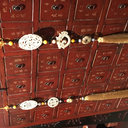Night Temperature Affects the Growth, Metabolism, and Photosynthetic Gene Expression in Astragalus membranaceus and Codonopsis lanceolata Plug Seedlings.
Mots clés
Abstrait
Astragalus membranaceus and Codonopsis lanceolata are two important medical herbs used in traditional Oriental medicine for preventing cancer, obesity, and inflammation. Night temperature is an important factor that influences the plug seedling quality. However, little research has focused on how the night temperature affects the growth and development of plug seedlings of these two medicinal species. In this study, uniform plug seedlings were cultivated in three environmentally controlled chambers for four weeks under three sets of day/night temperatures (25/10 °C, 25/15 °C, or 25/20 °C), the same relative humidity (75%), photoperiod (12 h), and light intensity (150 μmol·m-2·s-1 PPFD) provided by white LEDs. The results showed that night temperature had a marked influence on the growth and development of both species. The night temperature of 15 °C notably enhanced the quality of plug seedlings evidenced by the increased shoot, root, and leaf dry weights, stem diameter, and Dickson's quality index. Moreover, a night temperature of 15 °C also stimulated and increased contents of primary and secondary metabolites, including soluble sugar, starch, total phenols and flavonoids. Furthermore, the 15 °C night temperature increased the chlorophyll content and stomatal conductance and decreased the hydrogen peroxide content. Analysis of the gene expression showed that granule-bound starch synthase (GBSS), ribulose bisphosphate carboxylase large chain (RBCL), and ferredoxin (FDX) were up-regulated when the night temperature was 15 °C. Taken together, the results suggested that 15 °C is the optimal night temperature for the growth and development of plug seedlings of A. membranaceus and C. lanceolata.


